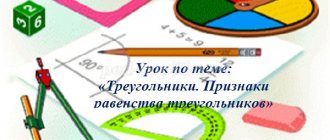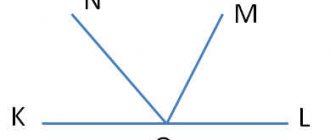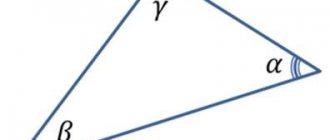Problems on signs of equality of triangles (grade 7)
Problems on the topic Tests for the equality of triangles
1.
Segments AB and CD intersect at point O, which is the midpoint of each of them.
What is the segment BD equal to if the segment AC = 10 m 2?
A straight line is drawn through the middle O of the segment AB, perpendicular to the straight line AB.
Prove that each point X of this line is equally distant from points A and B 3.
Point D is taken on side AB of triangle ABC, and point D1 is taken on side A1B1 of triangle A1B1C1.
It is known that triangles ADC and A1D1C1 are equal and segments DB and D1B1 are equal. Prove the equality of triangles ABC and A1B1C1 4.
To measure on the ground the distance between two points A and B, between which it is impossible to go in a straight line, choose a point C from which you can go to both point A and point B and from which both are visible these points.
Measure the distances AC and BC, continue them beyond point C and measure CD = AC and EC = CB. Then the segment ED is equal to the required distance. Explain why 5.
Segments AB and CD intersect at point O. Prove the equality of triangles ACO and DBO, if it is known that angle ACO is equal to angle DBO and BO = CO
6.
Segments AC and BD intersect at point O. Prove the equality of triangles BAO and DCO , if it is known that the angle BAO is equal to the angle DCO and AO = CO
7.
Prove the equality of the triangles by the median and the angles into which the median divides the angle of the triangle
9.
The perimeter of an isosceles triangle is 1 m, and the base is 0.4 m. Find the length of the side sides
10.
The perimeter of an isosceles triangle is 7.5 m, and the side is 2 m. Find the base
11.
The perimeter of an isosceles triangle is 15.6 m. Find its sides if the base: 1) is 3 m less than the side;
2) more than the side side by 3 m 12.
Prove that all angles of an equilateral triangle are equal
13.
From vertex C of isosceles triangle ABC with base AB equal segments are laid out: CA1 on side CA and CB1 on side CB.
Prove the equality of triangles 1) CAB1 and CBA1; 2) ABB1 and BAA1 14.
Based on AB of the isosceles triangle ABC, points A1 and B1 are given.
It is known that AB1 = BA1. Prove that triangles AB1C and BA1C are equal to 15.
Triangles ACC1 and BCC1 are equal.
Their vertices A and B lie on opposite sides of straight line CC1. Prove that triangles ABC and ABC1 are isosceles 16.
Formulate and prove the theorem converse to the statement of problem No. 12
17.
Points C1 and C2 are taken on sides AC and BC of triangle ABC.
Prove that triangle ABC is isosceles if triangles ABC1 and BAC2 are equal to 18.
1) Prove that the midpoints of the sides of an isosceles triangle are also the vertices of an isosceles triangle.
2) Prove that the midpoints of the sides of an equilateral triangle are also the vertices of an equilateral triangle 20.
Prove that for an isosceles triangle: 1) the bisectors drawn from the vertices at the base are equal;
2) medians drawn from the same vertices are also equal to 21.
Prove that for equal triangles ABC and A1B1C1: 1) medians drawn from vertices A and A1 are equal;
2) the bisectors drawn from vertices A and A1 are equal to 22.
Points A, C, B, D lie on the same line, and segments AB and CD have a common midpoint.
Prove that if triangle ABE is isosceles with base AB, then triangle CDE is also isosceles with base CD 23.
Prove the equality of the triangles by angle, the bisector of this angle and the side adjacent to this angle
24.
In an isosceles triangle ABC with base AC, the median BM is drawn.
Point D is taken on it. Prove the equality of the triangles: 1) ABD and CBD; 2) AMD and CMD 25.
Prove that triangle ABC is isosceles if its 1) median BD is the height;
2) the height BD is a bisector; 3) the bisector BD is the median 26.
Given two isosceles triangles with a common base.
Prove that their medians drawn to the base lie on the same straight line 27.
In an isosceles triangle ABC with base AC the median BD is drawn.
Find its length if the perimeter of triangle ABC is 50 m, and triangle ABD is 40 m 28.
Prove that the bisector of an isosceles triangle drawn from the vertex opposite the base is the median and altitude
29.
For triangles ABC and A1B1C1 AB = A1B1, AC = A1C1, C = C1 = 90(rectangular).
Prove that ΔABC = ΔA1B1C1 30.
Prove that for an isosceles triangle, the height a, lowered to the base, is the median and bisector
31.
Triangles ABC and ABC1 are isosceles with a common base AB.
Prove the equality of triangles ACC1 and ВСС1 32.
Points A, B, C, D lie on the same straight line.
Prove that if triangles ABE1 and ABE2 are equal, then triangles CDE1 and CDE2 are also equal 33.
Two segments AB and CD intersect at point O, which is the midpoint of each of them.
Prove the equality of triangles ACD and BDC 34.
Prove the equality of triangles by two sides and the median drawn to one of them
35.
Segments AB and CD intersect.
Prove that if the segments AC, CB, BD and AD are equal, then the ray AB is the bisector of the angle CAD and the ray CD is the bisector of the angle ACB 36.
Prove that in problem No. 35 the straight lines AB and CD are perpendicular
37.
Triangles ABC and BAD are equal, and Points C and D lie on opposite sides of line AB.
Prove that 1) triangles CBD and DAC are equal; 2) straight line CD divides segment AB in half 38.
Segments of equal lengths AB and CD intersect at point O so that AO = OD.
Prove the equality of triangles ABC and DCB 39.
Prove the equality of triangles by two sides and the median emanating from one vertex
40.
Prove the equality of triangles by a side, the median drawn to this side, and the angles that the median forms with it
.
Solving problems using signs of equality of triangles
1) Author: Kozlova Tatyana Gennadievna
2) 2nd qualification category
3) village Pristantsionny, Totsk district, Orenburg region
4) MBOU Station basic secondary school
5) discipline: geometry
6) textbook: L.S. Atanasyan et al. Geometry 7-9
7) lesson Solving problems using signs of equality of triangles
 7th grade
7th grade
9) lesson duration: 45 minutes Literature used:
1. Atanasyan L.S., Butuzova V.F. and other textbook Geometry 7-9.- M.: Education, 2005
2. Gavrilova N.F. Lesson developments in geometry. Grade 7 - 2nd edition - M.: VAKO, 2006
3. Panarina V.I. Geometry. Diagnostic tests. 7th grade - M.: National Education, 2012
4. Mishchenko T.M. Geometry workbook. — M.: Astrel, 2012 Solving problems on the use of signs of equality of triangles
Topic
: solving problems on the use of signs of equality of triangles
Target
: development of students’ ability to apply signs of equality of triangles when solving geometric problems;
Tasks
:
educational:
· repeat and systematize students’ knowledge on the topic “Signs for the equality of triangles”
· develop students’ ability to formulate solutions to geometric problems, carry out proofs, and build a chain of logical reasoning leading to solving the problem;
developing:
· develop students’ attention, logical thinking, and mathematical speech;
educating:
· to cultivate in students a respectful attitude towards the opinions of others, to develop the independence of schoolchildren.
Lesson type
: lesson on the integrated application of students’ knowledge, skills and abilities
Lesson form
: traditional
Equipment
: board, notebook, textbook, cards (Appendix 1, Appendix 2, Appendix 3).
Lesson Plan
:
1. Organizational moment (3 min.)
2. Updating knowledge (10 min.)
3. Problem solving (20 min.)
4. Homework (2 min.)
5. Test work (10 min.)
6. Summary (1 min) Lesson
progress
I. Organizational moment: The teacher greets the students. Familiarize students with the lesson plan. II .
Updating knowledge Individually at the board,
3 people prepare a proof:
a) the first sign of equality of triangles (first person);
b) the second sign of equality of triangles (second person);
c) the third sign of equality of triangles (third person). With the whole class (orally)
: solving card tasks (Appendix 1). 1. Indicate the numbers of the correct statements:
1) Geometry is a science in which figures on a plane are studied.
2) Two lines that do not coincide can have only one common point.
3) A segment is a part of a line that consists of all points of this line lying between two given points.
4) If point C lies on segment AB, then the length of segment AC is equal to the sum of the lengths AB and BC.
5) The length of the segment can be measured with a ruler.
6) A segment is not a geometric figure. 2. Solve problems:
1) Point Q is marked on the segment FN. It is known that FQ is 2 times larger than QN. What is the length of segment FQ if FN is 240 cm? Give your answer in decimeters.
2) Ray BM passes between the sides of angle ABC. It is known that angle ABM is 30 less than angle MBC. What is the degree measure of angle MVS if angle ABC is 150? Hearing of Evidence
III .
Solving problems 1. Solving problems using ready-made drawings (written in a notebook with comments on the spot) - (Appendix 2):
Problem 1
Given:
AB = AC, angle ACF is equal to angle ABD
Prove: equality of angles ACF and ABD
Suggestive questions:
1. What needs to be proven? (equal angles ACF and
ABD
)
2. What do we rely on when solving geometric problems? (for definitions and theorems)
3. What theorems will help us prove the equality of triangles? (students formulate signs that triangles are equal)
List the equal elements of these triangles. (AB = AC, angle ACF is equal to angle ABD - by condition)
4. How many equalities did you get? (two)
5. Find 1 more equal element for these triangles. (angle A - common)
6. Write down the solution to the problem.
Solution
:
AB = AC (by condition), angle ACF is equal to angle ABD (by condition), angle A is the total angle ACF is equal to angle ABD (by 2 signs of equality of triangles). Q.E.D.
Problem 2
Given: AF = 15 cm, FC = 10 cm, AC = 7 cm (Fig. 1)
Find the sides of triangle ABD.
Solution
In Problem 1 we proved that triangle ACF is equal to triangle ABD. From the equality of triangles it follows that the corresponding sides are equal, therefore AF = AD = 15 cm, FC = BD = 10 cm, AC = AB = 7 cm.
Problem 3
Given: AO = OC, angle BAO is equal to angle DCO. (Figure 2)
Prove: AB = CD
Suggestive questions
:
1.
How can the sides of triangles be equal?
(from the equality of the given triangles) 2.
Indicate the equal elements of the given triangles.
(AO = OS, angle BAO is equal to angle DCO ) 3.
Which of the signs for the equality of triangles can be useful to us?
(first or second) 4.
Write down the solution to the problem.
Solution
AO = OS, angle BAO = angle DCO (by condition), angle AOB = angle COD (since the angles are vertical). Then, according to the second criterion, triangles VAO and DCO are equal. Therefore, AB = CD.
Problem 4
Given: AB = DC AD= BC PABC= 15 cm PABCD=20 cm (Figure 3) Find: AC
Solution:
1. PABCD=20 cm, PABCD= AB + BC + CD+ AD. Let us denote AB = x, BC = y, then PABCD= AB + BC + CD+ AD= 2(x+y). Hence x + y= 10.
2. PABC= 15 cm. PABC= AB + BC + SA. Hence CA = 15 - 10 = 5 (cm) Answer
: 5 cm.
Problem 5
Given: AB = BC AD = DC angle ABD = 63 angle ADB = 37 (Figure 4) Find: angle CBD, angle CDB.
Solution:
1. Since AB = BC (by condition), AD= DC (by condition), BD is a common side, then triangle ABD is equal to triangle CBD 2. angle CBD is equal to angle ABD and is equal to 63, angle CDB is equal to angle ADB and is equal to 37
Answer
: angle CBD = 63, angle CDB = 37
2. Working with the textbook
№ 158
Suggestive questions
· Read the problem · Where does solving geometric problems begin? (from drawing) · What figure is given? (isosceles triangle) · Which triangle is called isosceles? · What theorems do you know about isosceles triangles? · Construct a drawing of an isosceles triangle. · What is known about this triangle? What is the median of a triangle? · How to mark the median of a triangle in a drawing? · Note the median AD. · What is known about perimeters? · What do you need to find? Given:
ABC - isosceles AC - base AC = 8 cm AD - median a) RABD> PADC by 2 cm b) RABD < PADC by 2 cm
Find: AB
Solution.
1. Let BD= xcm, which means DC= x cm, since AD is the median. Therefore, BC = AB = 2x cm, since the triangle ABC is isosceles.
2. Let us denote AD by y. Case 1: RABD= 2x + x + y, and the perimeter of triangle ADC is 8+x+y. Let's find the difference between the values of perimeter ABD and perimeter ADC: 2=2x-8. Having solved the resulting equation, we find x=5. 5 cm is the length BD, then AB = 10 cm.
Case 2: If the perimeter of triangle ADC is 2 cm greater than the perimeter of triangle ABD, then subtract the smaller value from the larger value. As a result, we get the equation: 2=-2x+8. Having solved this equation, we find the value of x equal to 3., that is, 3 cm is the length BD, then AB = 6 cm Answer: 6 cm or 10 cm.
IV . Homework
No. 157, No. 162(b ) V. Verification work
(Appendix 3) 1. Indicate the numbers of the drawings that show equal triangles, write down the equality of triangles in brackets and indicate the number of the sign of equality of triangles on which you relied when making your conclusion.
2. Segment DA—the median of the isosceles triangle BDC, drawn to the base NE. Find the angles of triangle ADC, if angle BDC is 120, angle DBC is 30. VI .
Summary · what theorems did we use in the lesson? · why are theorems needed?
Geometry grade 7 explanation of the main topics, understandable for children
first geometric objects
It’s worth starting with the very concept of “geometry”. From ancient Greek the word is translated as earth and dimension. This is an ancient science that appeared in connection with the need to build buildings, roads, measure objects and draw boundaries.
The first geometric figures that are worth learning are a point, a straight line, and a segment.
A point is an abstract object in space. It does not have any measuring characteristics (but coordinates can be determined).
Through two points you can draw a straight line (and the only one); it does not bend, has no end or beginning, and continues indefinitely.
In other words, a straight line is a set of points on one line, continuing to infinity.
Remember an important axiom:
If you limit part of a straight line with points, you get a segment. A segment has both a beginning and an end. It is designated in capital letters (for example, segment KL, SD, AB, etc.).
If two lines intersect at an angle of 90º, then they are said to be perpendicular.
If you limit the straight line to only one point, you get two rays. The ray has a beginning, but no end (it goes to infinity). The beam is called by two letters, for example, OA.
Another figure is an angle. It represents a point and two rays emanating from it. The rays are the sides of the angle, and the beginning of these sides is its vertex. How many degrees the angle makes determines the type of triangle that can be formed.
About equal triangles. Isosceles triangle
A triangle is considered to be a figure that consists of 3 points. Moreover, these points should not lie on the same straight line, but they are connected by segments.
The sum of all angles in a triangle is 180º. Knowing this fact will be useful when solving problems of finding angles.
Triangles can be distinguished by two characteristics: the size of the sides and the size of the corners.
If one triangle (let's call it CFD) is superimposed on another (C1F1D1) and they correspond to each other, then the triangles are equal. Equal figures have all elements equal.
To understand whether triangles are equal, let’s get acquainted with the signs of equality of these figures.
Let us dwell separately on isosceles triangles. If 2 sides of a triangle are equal, then it is called isosceles.
On a note! If all sides are equal, and not just two, then the triangle is already equilateral, and not isosceles.
Based on this, we can identify the characteristics of an isosceles triangle. A triangle is isosceles if:
- 2 angles in it are equal;
- the bisector is both the height and the median;
- median - bisector and height;
- height, respectively - median and bisector.
If we take an isosceles triangle, then these three components (height, bisector and median) will not coincide (this can be clearly seen in the figure below).
parallel lines
If on a notebook sheet it seems that the lines are parallel, but there is a slight slope, then it is quite likely that outside the sheet (after all, they are infinite), the lines will intersect.
To understand whether straight lines are parallel, you need to learn 3 main signs.
You can show the parallelism of lines a and b as follows: a ΙΙ b.
right triangle and its properties
A triangle in which one of the angles is equal to 90º is called a right triangle. Let's consider the name of the sides of such a figure.
Geometric proof problems. Signs of equality of triangles.
All problems are taken from the book “OGE 2020. Mathematics. Typical exam options. 36 options. Edited by I.V. Yashchenko”
Task 1 . Two segments and intersect at point O, which is the midpoint of each of them. Prove the equality of triangles and .
To task 1
Consider triangles COB and AOD. They have equal sides: CO=OD, AO=OB – according to the condition. Angle COB is equal to angle AOD (vertical). Thus, triangles COB and AOD are equal according to the first criterion. Then CB=AD.
Consider triangles COA and BOD. They have equal sides: CO=OD, AO=OB – according to the condition. Angle COA is equal to angle BOD (vertical). Thus, triangles COA and BOD are equal according to the first criterion. Then CA=BD.
Triangles ACD and BDC have a common side - CD. Thus, they are equal according to the third criterion, etc.
Task 2 . The rays and intersect at point O, angle 1 is equal to angle 2, . Prove that .
To task 2
To prove that OA = OB, you will need to prove the equality of triangles AOC and OBD. In these triangles we have one equal element: we are given that OC=OD. It is also known that angle 1 is equal to angle 2. Then angle , and angle , which means that angle . Let's add to this the equality of the angles AOC and BOD - they are vertical. Thus, we have an equal side and two equal angles adjacent to it - and this is the second sign of equality of triangles. Since the triangles are equal, then their elements are equal: OA=OB, etc. Task 3 . In triangle ABC and angle 1 is equal to angle 2. Prove that angle 3 is equal to angle 4.
To problem 3
Consider triangle ABC. We are given that it is isosceles. This means that the angles at its base are equal: angle C is equal to angle B. Then triangles CDA and ABE are equal according to the second criterion: angle 1 is equal to angle 2 by condition, CA = AB. Then the corresponding elements in these triangles are equal: DA=AE. This means that, in turn, triangle DEA is also isosceles. And this means that the angles at its base are equal, i.e. angle 3 is equal to angle 4, etc.
Task 4 . In the figure and. Prove that .
To problem 4
The equality of BD and CE can be proven if we can prove the equality of triangles ABD and AEC.
Since and , then . These triangles have the same angle A, so they are equal according to the first criterion. And this means that, etc.
Task 5 . Prove that for congruent triangles and the medians drawn from the vertices and are equal.
Since , then , that is , and also from the equality of triangles it follows that . Since the triangles are congruent, the angles are congruent: an angle is equal to an angle. But then triangles have equal angles and adjacent sides; they are equal according to the first criterion. Then, etc.
To problem 5






